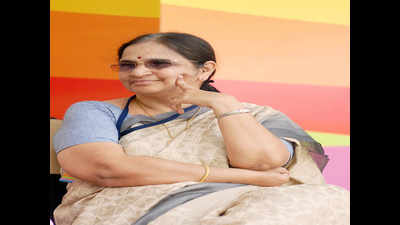- News
- City News
- jaipur News
- May be Ravana loved Sita more than Rama
Trending
This story is from January 21, 2017
May be Ravana loved Sita more than Rama
Some years ago, when ‘Three Hundred Ramayanas: Five Examples and Three Thoughts on Translations’ by A K Ramanujan was dropped from the syllabus of Delhi University, it raised a hue and cry. What is comforting, though, is that the bold retellings of Ramayana continue.

Popuri Lalitha Kumari.
JAIPUR: Some years ago, when ‘Three Hundred Ramayanas: Five Examples and Three Thoughts on Translations’ by A K Ramanujan was dropped from the syllabus of Delhi University, it raised a hue and cry. What is comforting, though, is that the bold retellings of Ramayana continue.
Volga’s recounting of the tales of Ramayana was one such event at Jaipur Literature Festival (JLF) on Friday, which left the audience amazed.
“I sometimes have to tell my readers that what I write is my own story. They assume it is Valmiki’s,” Volga, the author of ‘The Liberation of Sita,’ a collection of stories that appeared originally in Telugu, said.
Recounting one of her stories, Volga (the adopted pen name of Popuri Lalitha Kumari), said Sita, at the point of her test by fire to prove her chastity to Lord Rama, thinks that perhaps Ravana loved her more than her husband – he had staked his honour, his kingdom, his very life for her.
Volga’s tales also underline the sisterhood among different characters in the epic. She looks at the plight of Urmila, the wife of Lakshmana, who is deserted for 14 years during the exile of Ram. She also contemplates, in her stories, a meeting between Surpanakha, Ravana’s sister, and Sita – Surpanakha shows Sita that she can find meaning in life even without defining herself primarily as wife or mother.
Author and translator Arshia Sattar, former student of Indologist Wendy Doniger at Chicago, dwelt on how Valmiki’s Ramayana was replete with possibilities for retelling in dramatic new ways. Volga agreed that the seeds of a radical retelling were already present in the epic, making possible her flights of fancy. Sattar also pointed out that it was fortuitous that there was a parallel session at the JLF on the RSS. “The people who might have shouted in protest here are busy there!”
Volga’s recounting of the tales of Ramayana was one such event at Jaipur Literature Festival (JLF) on Friday, which left the audience amazed.
“I sometimes have to tell my readers that what I write is my own story. They assume it is Valmiki’s,” Volga, the author of ‘The Liberation of Sita,’ a collection of stories that appeared originally in Telugu, said.
Recounting one of her stories, Volga (the adopted pen name of Popuri Lalitha Kumari), said Sita, at the point of her test by fire to prove her chastity to Lord Rama, thinks that perhaps Ravana loved her more than her husband – he had staked his honour, his kingdom, his very life for her.
In comparison, her own husband had offered her little. Walking into the fire, she tells herself, “I shall enter into the pyre of Ravana,” thus performing sati.
Volga’s tales also underline the sisterhood among different characters in the epic. She looks at the plight of Urmila, the wife of Lakshmana, who is deserted for 14 years during the exile of Ram. She also contemplates, in her stories, a meeting between Surpanakha, Ravana’s sister, and Sita – Surpanakha shows Sita that she can find meaning in life even without defining herself primarily as wife or mother.
Author and translator Arshia Sattar, former student of Indologist Wendy Doniger at Chicago, dwelt on how Valmiki’s Ramayana was replete with possibilities for retelling in dramatic new ways. Volga agreed that the seeds of a radical retelling were already present in the epic, making possible her flights of fancy. Sattar also pointed out that it was fortuitous that there was a parallel session at the JLF on the RSS. “The people who might have shouted in protest here are busy there!”
End of Article
FOLLOW US ON SOCIAL MEDIA










